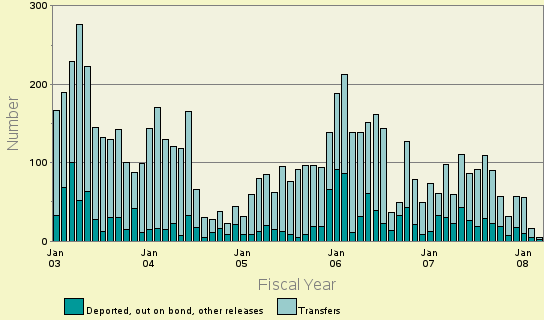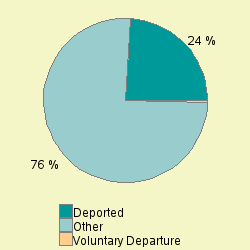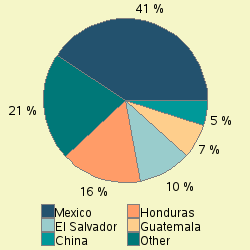Detainees Leaving ICE Detention from the
Western Tennessee Detention Center
Mason, Tennessee
Detainees Deported or Released Number last 12 months 221 Out of total detained 766 Percent change: from previous 12 months -36 % from FY 2005 56 % from FY 2000 -29 % Facility ranking on detainees top 42 %
Table 1: Number leaving ICE detention
from this facilityDuring the most recent 12 month period for which data are available, a total of 221 detainees housed at the Western Tennessee Detention Center left that facility because they were deported, were released under supervision while their cases were being decided, or left ICE detention for one of a variety of other reasons. The use of this facility for the temporary housing of federal immigration detainees was arranged through an intergovernmental service agreement (IGSA) under which payments by ICE to another governmental agency are made for housing federal detainees. While the facility is government owned, it is operated by the Corrections Corporation of America that was in the business of providing detention services for housing federal detainees.
Those individuals who departed from this facility because they were leaving ICE detention made up 29 percent of the 766 detainees housed at this facility during the last 12 months. This report focuses on the reasons these individuals left ICE detention. Sometimes this report speaks of these individuals as those "exiting" ICE detention, or simply as "exits." The other 71 percent remained in ICE detention but were transferred from the Western Tennessee Detention Center to other facilities.
This report covers those who left ICE custody. It excludes individuals transferred to other ICE facilities. For more information on this facility, including individuals that were transferred, see additional TRAC reports in this series.
This report series is based upon analyses conducted by the Transactional Records Access Clearinghouse (TRAC) at Syracuse University of 3.4 million government records tracking each individual who passed through an ICE detention facility during the past decade. The most recent 12 month period for which comprehensive data are available is for April 2007 through March 2008. See About the Data.
How This Facility Ranks Nationally
Rankings on the number leaving ICE detention. The Western Tennessee Detention Center was one of 1,528 facilities that were used to house immigration detainees during the last decade, and one of 654 facilities nationwide that housed ICE detainees during the most recent 12 month period. Of these 654, there were 324 facilities that had at least 10 individuals who were deported or released. Excluding those facilities with fewer than 10 exits, the Western Tennessee Detention Center last year ranked in the top 42 percent nationwide in the number of individuals leaving ICE detention. This means that 42 percent of the locations contributed the same or a larger numbers of exits, while 58 percent had a smaller number. See Table 1.
Deportations. Nationally, the most common reason that a detainee left ICE detention was that they were deported from the United States. During the most recent 12 month period for which comprehensive data are available, nationwide 81 percent of those leaving ICE detention were deported or "voluntarily" departed. By way of comparison, a lower percentage of detainees (24 percent) left the country from the Western Tennessee Detention Center because they were formally deported, or left under the so-called "voluntary departure" procedure.
Trends in the Number of Detainees Deported or Released
Trends in the number leaving ICE detention. When deportations and other releases during the April 2007-March 2008 period were compared with those in the previous 12 months, the Western Tennessee Detention Center numbers were down by 36 percent. During the April 2006-March 2007 period the facility processed 344 "exits" as compared with 221 last year. As detailed in Table 1, numbers last year were however up 56 percent as compared with the number of those leaving ICE detention (142) during FY 2005. Exits last year were however down by 29 percent as compared with the number of exits (312) during FY 2000.
Longer term exit trends. Greater detail on these long-term trends for those leaving ICE detention from the Western Tennessee Detention Center are displayed in Figure 1. Here the month-by-month number of exits are graphed against the backdrop of the total detainees leaving the custody of this facility. Exits are displayed with darker shading while those transferred appear with lighter shading. As is readily apparent, considerable variation has occurred over time in both the overall numbers of detainees as well as the volume leaving ICE detention during this period.
Fiscal Year ICE Detainees Total Exits Percent 1999 312 66 21 % 2000 860 312 36 % 2001 1,559 818 52 % 2002 2,010 366 18 % 2003 2,048 479 23 % 2004 1,259 207 16 % 2005 780 142 18 % 2006 1,547 488 32 % 2007 1,033 308 30 % 2008 (est) 456 128 28 %
Table 2: Number of detainees leaving
this facility over the last decade
Exit trends are also summarized by fiscal year in Table 2. Year-by-year figures for the Western Tennessee Detention Center are given for the total number of detainees as compared with those leaving ICE detention from the facility. The percent of detainees that left ICE detention is also given. (As mentioned above, the remaining detainees were transferred to another ICE detention facility.) Because data for all twelve months of the most recent fiscal year are not yet available, the FY 2008 numbers (October 2007 through September 2008) are estimated based upon reporting for the first six months.
Were Detained Individuals from the Local Area?
Information on the place of arrest was not included in the available data ICE released. However, we can examine whether the Western Tennessee Detention Center was the first ICE facility in which these detainees were held. According to ICE records, for a substantial proportion (47 percent) of these detainees, the Western Tennessee Detention Center was the first place they were sent when they were detained by ICE. The remaining 53 percent had been transferred in from another ICE detention facility.
We can also look at how quickly they arrived at this facility after they were first detained. Again, a total of 47 percent arrived at the Western Tennessee Detention Center at some point during the very first day they were detained by ICE. There was considerable variability among detainees in the number of detention facilities they had been held in before they were finally deported or released from this facility. The number of facilities ranged as high as 6 separate locations for some detainees. These figures again are based on an analysis of the most recent 12 months for which data are available.
For the United States as a whole, last year the typical detainee stayed in two different ICE detention facilities before being deported or released - half stayed in 2 or fewer facilities, and half stayed in 2 or more. The average number of ICE facilities detainees moved through was 1.9. Detainees at the Western Tennessee Detention Center on average had stayed at somewhat fewer (1.7) ICE facilities.
Reason Left ICE Facility Profile U.S Profile Number Percent Percent Bonded out 127 57 % 8 % Deported/Removed 53 24 % 72 % U.S. Marshal or Other Agency 23 10 % 3 % Orders of Recognizance or Supervision 11 5 % 5 % Proceedings Terminated 3 1 % 2 % Withdrawal 3 1 % 1 % Voluntary departure 1 0 % 10 % Died 0 . 0 % Escaped 0 . 0 % Paroled 0 . 0 % Total 221 100 % 100 %
Table 3: Reasons individuals left ICE detention during the last 12 months
Why Did Detainees Leave ICE Detention?
ICE records one of twenty-three reasons a detainee left ICE detention. As shown in Table 3, these reasons fall into ten general categories -- from leaving because one is deported or removed, to leaving because one escaped or the individual died while in custody.
Deportation. As mentioned earlier, while nationally the most common reason that a detainee left ICE detention was that they were deported from this country, this was not the top reason at this facility. At the Western Tennessee Detention Center only 53 individuals (24 percent) were deported or removed during the most recent 12 month period for which data are available. (ICE data did not distinguish between deportations and removals, and the terms are used interchangeably in this report.)
Bonded out. The most common reason a person left ICE detention from this facility was that they were released after posting a bond. A total of 127 individuals (57 percent) left the Western Tennessee Detention Center because they were "bonded out." This generally covers situations where the individual posts a bond and is released while awaiting a decision on their deportation (removal) case. The amount of the bond is set by ICE, or by an Immigration Judge. Many individuals are not eligible to be released because their continued detention is considered mandatory under provisions in the immigration laws.
Transferred to criminal custody. A total of 23 individuals (10 percent) left this facility last year because they were turned over to U.S. Marshals or to some other government agency. This typically occurs because there is an outstanding criminal case against the individual, or the individual is needed as a material witness in a criminal case.
Orders. Orders are additional mechanisms that are sometimes used to release a person while their case is pending, or awaiting removal. Under an "order of recognizance" an individual is released with reporting conditions while in deportation proceedings and awaiting a final decision. A second type of order ("order of supervision") releases an individual after a final order of removal. Here an individual is released because ICE has not met the time limits the law imposes for deporting the individual. There were 11 (5 percent) who left the Western Tennessee Detention Center detention for these reasons: 2 with orders of recognizance, and 9 with orders of supervision.
No legitimate grounds to deport. Sometimes individuals left ICE detention because they "won" their case. Typically this occurs when an Immigration Judge orders the deportation proceedings ICE has filed against them "terminated" (dismissed) and the judge's order after any appeals becomes final. Analysis of the latest 12 months of data show that a total of 3 individuals, or 1 percent were released from detention by the Western Tennessee Detention Center because a determination was made that there were no grounds to deport the individuals and thus ICE had to release them from custody.
Withdraw entry request. Individuals also leave ICE detention for a variety of additional reasons. One of these is that individuals who have been detained may be allowed to "withdraw" their request to enter the country. If a person withdraws their request, this effectively means they must leave the country. A total of 3 individuals (1 percent) fell into this category. Unlike deportation where the person is legally barred for a period of years and sometimes permanently from coming back to the United States, a person who withdraws their request is not for that reason barred from re-entry into this country.
Escape and death. Nationally, there were 92 individuals who escaped ICE detention during the latest 12 month period for which data are available, and 8 individuals were recorded as having died in detention. No one was recorded by the Western Tennessee Detention Center as either escaping or dying last year. Over the past decade, one death was recorded from this facility, but no escapes.
As shown in Table 3, no one was recorded as leaving the Western Tennessee Detention Center during the past 12 months for the following reason: Paroled. See "Reasons for Leaving ICE Detention" for a description of this category.
Comparing Release Reasons Against The National Picture
In many respects release reasons for the Western Tennessee Detention Center departed from the national picture. It was the case that a lower proportion left because they were deported from this facility (24 percent) than was true for the U.S. as a whole (72 percent). A lower proportion (0 percent) left this facility as voluntary departures than was true nationally (10 percent).
In addition, differences were seen for individuals released on bond (57 versus 8 percent), and those released to the U.S. Marshal or other agency (10 versus 3 percent).
The facility's percentages fell within 3 percentage points of the national figures for all other categories.
Nationalities
Which nationalities predominate? Last year in the United States, individuals from Mexico comprised the largest number of those leaving ICE detention. Some 53.6 percent of all detainees recorded Mexico as their country of origin. The Western Tennessee Detention Center had a smaller proportion of detainees from Mexico - 41 percent among their exits. Detainees from Mexico were also the largest single nationality group among those leaving detention from the facility.
Nationalities Ranked in Top 10 Left ICE Detention Total Deported/
Voluntary
DeparturePercent - ALL 221 54 24.4 % 1 Mexico 90 1 1.1 % 2 Honduras 35 13 37.1 % 3 El Salvador 23 15 65.2 % 4 Guatemala 15 6 40.0 % 5 China 11 0 0.0 % 6 Brazil 5 3 60.0 % Jordan 5 2 40.0 % 8 Russia 3 0 0.0 % 9 Canada 2 2 100.0 % Colombia 2 0 0.0 % Kenya 2 1 50.0 % Nicaragua 2 2 100.0 % Peru 2 1 50.0 % Philippines 2 1 50.0 % Uzbekistan 2 1 50.0 %
Table 4: Numbers leaving ICE detention by nationality
during the last 12 months
In descending order, the other top nationalities after Mexico that made up those leaving ICE detention from the Western Tennessee Detention Center last year were: Honduras (16%), El Salvador (10%), Guatemala (7%) and China (5%). This compared to the United States as a whole where the other top five nationalities after Mexico were Honduras (11.0%), Guatemala (10.0%), El Salvador (8.4%) and Dominican Republic (1.6%).
For the frequency for each of the other nationalities among those leaving ICE detention from the Western Tennessee Detention Center last year see Table 4.
Deportations and voluntary departures by nationality. Within the nationalities that made up those listed in Table 4 with more than one individual, the proportion deported or voluntarily departing varied from 0 percent to 100 percent. As mentioned above, this compares with 24 percent for all detainees.
More than one country was tied with the highest rate of 100 percent, where detainees were deported or took voluntary departure. More than one country was tied with the lowest rate, where detainees were deported or took voluntary departure.



